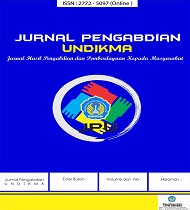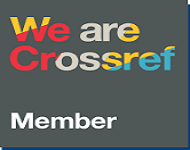Relevance between Blended Learning and Students' Independent Learning Curriculum : An Overview of Digital Age Education, Student and Teacher Engagement, Technological Resources.
DOI:
https://doi.org/10.33394/jk.v9i3.8320Keywords:
Blended Learning, Independent Learning Curriculum, Digital Age Education, Student Engagement, Teacher Support, Technological Resources.Abstract
References
Afandi, A., Sajidan, S., Akhyar, M., & Suryani, N. (2019). Development frameworks of the Indonesian partnership 21st-century skills standards for prospective science teachers: A Delphi Study. Jurnal Pendidikan IPA Indonesia, 8(1), 89-100.
Ahmad, T. (2020). The scenario-based approach to re-imagining the future of higher education prepares students for the future of work. Higher Education, Skills and Work-Based Learning, 10(1), 217–238.
Bawane, J., & Spector, J. M. (2009). Prioritization of online instructor roles: implications for competencyâ€based teacher education programs. Distance education, 30(3), 383-397.
Bereiter, C., & Scardamalia, M. (Eds.). (2013). The psychology of written composition. Routledge.
Boelens, R., De Wever, B., & Voet, M. (2017). Four key challenges to blended learning design: A systematic literature review. Educational Research Review, 22, 1-18.
Bowen, G. A. (2009). Document analysis as a qualitative research method. Qualitative research journal, 9(2), 27–40.
Braun, V., Clarke, V., & Hayfield, N. (2022). 'A starting point for your journey, not a map': Nikki Hayfield in conversation with Virginia Braun and Victoria Clarke about thematic analysis. Qualitative Research in Psychology, 19(2), 424–445.
Breen, P. (2018). Developing educators for the digital age: A framework for capturing knowledge in action (p. 218). University of Westminster Press.
Brockett, R. G., & Hiemstra, R. (2018). Self-direction in adult learning: Perspectives on theory, research, and practice. Routledge.
CHENG, C. K. E. (2011). The role of self-regulated learning in enhancing learning performance.
Contreras, D., Robles, V., & Choi, P. I. (2022). Self-guided Inquiry Modules for the Remote Teaching of Undergraduate Physics Labs.
Creswell, J. W. (2013). Steps in conducting a scholarly mixed methods study.
Curran, V., Gustafson, D. L., Simmons, K., Lannon, H., Wang, C., Garmsiri, M., ... & Wetsch, L. (2019). Adult learners’ perceptions of self-directed learning and digital technology usage in continuing professional education: An update for the digital age. Journal of Adult and Continuing Education, 25(1), 74-93.
Davies, H. E., Davies, R. J., & Davies, C. W. (2010). Management of pleural infection in adults: British Thoracic Society pleural disease guideline 2010. Thorax, 65(Suppl 2), ii41-ii53.
Field, J. (2000). Lifelong learning and the new educational order. Trentham Books, Ltd., Westview House, 734 London Road, Stoke on Trent, ST4 5NP, United Kingdom UK (15.99 British pounds; 25 Euros).
Garrison, D. R., & Kanuka, H. (2004). Blended learning: Uncovering its transformative potential in higher education. The Internet and higher education, 7(2), 95–105.
Garrison, D. R., & Vaughan, N. D. (2008). Blended learning in higher education: Framework, principles, and guidelines. John Wiley & Sons.
Graham, C. R. (2006). Blended learning systems. The Handbook of blended learning: Global perspectives, local designs, 1, 3-21.
Hew, K. F., & Brush, T. (2007). Integrating Technology into K-12 Teaching and Learning: Current knowledge gaps and Recommendations for future research. Educational Technology Research and Development, pp. 55, 223–252.
Hew, K. F., & Cheung, W. S. (2013). Use of Web 2.0 technologies in K-12 and higher education: The search for evidence-based practice. Educational research review, 9, 47-64.
Hughey, J. (2020). Individual personalized learning. Educational Considerations, 46(2), 10.
Hwang, C. L., Chen, B. L., Huang, H. H., & Syu, H. T. (2015). Hybrid learning model and MMSVM classification for on-line visual imitation of a human with 3-D motions. Robotics and Autonomous Systems, 71, 150-165.
Johnson, W. M., & Khoo, M. J. (2018). Analysing the learning commons in the digital age. Spaces of Teaching and Learning: Integrating Perspectives on Research and Practice, 105-128.
Kim, M. C., & Frick, T. W. (2011). Changes in student motivation during online learning. Journal of Educational Computing Research, 44(1), 1-23.
Kintu, M. J., Zhu, C., & Kagambe, E. (2017). Blended learning effectiveness: the relationship between student characteristics, design features, and outcomes. International Journal of Educational Technology in Higher Education, 14(1), 1-20.
Lai, E. R. (2011). Metacognition: A literature review. Always learning: Pearson research report, pp. 24, 1–40.
Lin, C. Y., Huang, C. K., & Ko, C. J. (2020). The impact of perceived enjoyment on team effectiveness and individual learning in a blended learning business course: The mediating effect of knowledge sharing. Australasian Journal of Educational Technology, 36(1), 126-141.
Margulieux, L. E., Bujak, K. R., McCracken, W. M., & Majerich, D. M. (2014, January). Hybrid, blended, flipped, and inverted: Defining terms in a two-dimensional taxonomy. In Proceedings of the 12th Annual Hawaii International Conference on Education, Honolulu, HI, January (Vol. 5, No. 9).
Means, B., Toyama, Y., Murphy, R., & Baki, M. (2013). The effectiveness of online and blended learning: A meta-analysis of the empirical literature. Teachers college record, 115(3), 1–47.
Merriam, S. B., & Tisdell, E. J. (2015). Qualitative research: A guide to design and implementation. John Wiley & Sons.
Morris, T. H., & König, P. D. (2020). Self-directed, experiential learning to meet ever-changing entrepreneurship demands. Education+ Training, 63(1), 23-49.
Okaz, A. A. (2015). Integrating blended learning in higher education. Procedia-Social and Behavioral Sciences, pp. 186, 600–603.
Olapiriyakul, K., & Scher, J. M. (2006). A guide to establishing hybrid learning courses: Employing information technology to create a new learning experience, and a case study. The Internet and Higher Education, 9(4), 287-301.
Patton, M. Q. (2002). Two decades of developments in qualitative inquiry: A personal, experiential perspective. Qualitative social work, 1(3), 261-283.
Peña-López, I. (2015). Students, computers, and learning. You are making the connection.
Picciano, A. G. (2021). Theories and frameworks for online education: Seeking an integrated model. In A guide to administering distance learning (pp. 79-103). Brill.
Rapanta, C., Botturi, L., Goodyear, P., Guà rdia, L., & Koole, M. (2021). Balancing technology, pedagogy and the new normal: Post-pandemic challenges for higher education. Postdigital Science and Education, 3(3), 715–742.
Rasheed, M. I., Malik, M. J., Pitafi, A. H., Iqbal, J., Anser, M. K., & Abbas, M. (2020). Usage of social media, student engagement, and creativity: The role of knowledge sharing behavior and cyberbullying. Computers & Education, 159, 104002.
Robb, K. A., Simon, A. E., Miles, A., & Wardle, J. (2014). Public perceptions of cancer: a qualitative study of the balance of positive and negative beliefs. BMJ open, 4(7), e005434.
Schworm, S., & Gruber, H. (2017). Academic help-seeking: The influence of epistemic beliefs, learning strategies, and goal orientation. Wissen und lernen. wie epistemische überzeugungen schule, universität und arbeitswelt beeinflussen (S. 143–162). Münster and New York: Waxmann.
Setyosari, P., Kuswandi, D., & Ulfa, S. (2023). Creative Problem Solving Process Instructional Design in the Context of Blended Learning in Higher Education. Electronic Journal of e-Learning, 21(2), 80-97.
Shen, J., Qi, H., Chen, Y., Mei, R., Sun, C., & Wang, Z. (2022). Incorporating modified team-based learning into a flipped introductory medical laboratory course: impact on student performance and perceptions. BMC Medical Education, 22(1), 1-9.
Simpson, A. J. (2016). The successful incorporation of blended learning into the Language curriculum. Advanced Education, pp. 96–107.
Warschauer, M., & Matuchniak, T. (2010). New Technology and digital worlds: Analyzing evidence of equity in access, use, and outcomes. Review of Research in Education, 34(1), 179-225.
Wu, W. H., Kao, H. Y., Wu, S. H., & Wei, C. W. (2019). Development and evaluation of affective domain using student’s feedback in entrepreneurial Massive Open Online Courses. Frontiers in psychology, 1109.
Downloads
Published
How to Cite
Issue
Section
Citation Check
License
License and Publishing Agreement
In submitting the manuscript to the journal, the authors certify that:
- They are authorized by their co-authors to enter into these arrangements.
- The work described has not been formally published before, except in the form of an abstract or as part of a published lecture, review, thesis, or overlay journal.
- That it is not under consideration for publication elsewhere,
- That its publication has been approved by all the author(s) and by the responsible authorities tacitly or explicitly of the institutes where the work has been carried out.
- They secure the right to reproduce any material that has already been published or copyrighted elsewhere.
- They agree to the following license and publishing agreement.
Copyright
Authors who publish with JK agree to the following terms:
- Authors retain copyright and grant the journal right of first publication with the work simultaneously licensed under a Creative Commons Attribution License (CC BY-SA 4.0) that allows others to share the work with an acknowledgment of the work's authorship and initial publication in this journal.
- Authors are able to enter into separate, additional contractual arrangements for the non-exclusive distribution of the journal's published version of the work (e.g., post it to an institutional repository or publish it in a book), with an acknowledgment of its initial publication in this journal.
- Authors are permitted and encouraged to post their work online (e.g., in institutional repositories or on their website) prior to and during the submission process, as it can lead to productive exchanges, as well as earlier and greater citation of published work.
Licensing for Data Publication
-
Open Data Commons Attribution License, http://www.opendatacommons.org/licenses/by/1.0/ (default)

This work is licensed under a Creative Commons Attribution-ShareAlike 4.0 International License.







